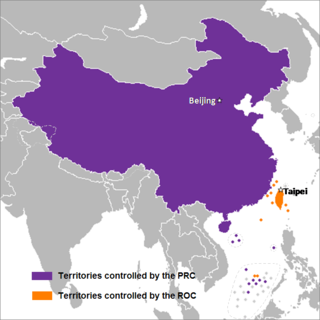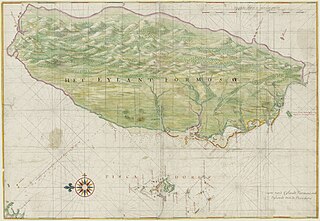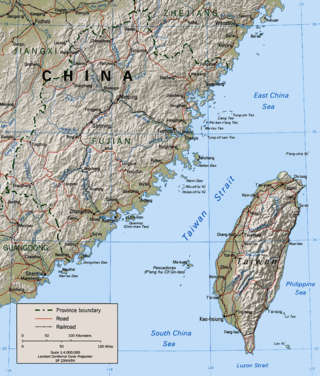Wars involving the Republic of China
- ROC military victory
- ROC military defeat
- Indecisive or unclear outcome
- Ongoing conflict
This is a list of wars involving the Republic of China .

The Republic of China Armed Forces are the armed forces of the Republic of China (ROC) that once ruled Mainland China and now currently restricted to its territorial jurisdictions of Taiwan, Penghu, Kinmen and Matsu Islands. They consist of the Army, Navy, Air Force and Military Police Force. The military is under the civilian control of the Ministry of National Defense, a cabinet-level agency overseen by the Legislative Yuan.

Chinese unification, also known as Cross-Strait unification or Chinese reunification, is the potential unification of territories currently controlled, or claimed, by the People's Republic of China and the Republic of China ("Taiwan") under one political entity, possibly the formation of a political union between the two republics. Together with full Taiwan independence, unification is one of the main proposals to address questions on the political status of Taiwan, which is a central focus of Cross-Strait relations.

The president of the Republic of China, commonly known as the president of Taiwan, is the head of state of the Republic of China (Taiwan) as well as the commander-in-chief of the Republic of China Armed Forces. The position once had authority of ruling over Mainland China, but its remaining jurisdictions has been limited to Taiwan, Penghu, Kinmen, Matsu, and other smaller islands since the conclusion of the Chinese Civil War.
The controversy surrounding the political status of Taiwan or the Taiwan issue is an ongoing dispute on the political status of Taiwan, currently controlled by the Republic of China (ROC). This dispute arose in the mid-twentieth century.

The National Day of the Republic of China, also referred to as Double Ten Day or Double Tenth Day, is a public holiday on 10 October, now held annually as national day in the Republic of China. It commemorates the start of the Wuchang Uprising on 10 October 1911 which ultimately led to the collapse of the imperial Qing dynasty, ending 2,133 years of imperial rule of China since the Qin dynasty and establishment of the Republic of China on 1 January 1912. The day was once held as public holiday in mainland China during the Mainland Period of the ROC before 1949. The subsequent People's Republic of China continues to observe the Anniversary of the Xinhai Revolution at the same date but not as a public holiday, which put more emphasis on its revolutionary characteristics as commemoration of a historical event rather than celebration to the founding of the Republic of China.

The flag of the Republic of China, commonly called the flag of Taiwan, consists of a red field with a blue canton bearing a white disk surrounded by twelve triangles; said symbols symbolize the sun and rays of light emanating from it, respectively.

As a result of the surrender and occupation of Japan at the end of World War II, the islands of Taiwan and Penghu were placed under the governance of the Republic of China (ROC), ruled by the Kuomintang (KMT), on 25 October 1945. Following the February 28 massacre in 1947, martial law was declared in 1949 by the Governor of Taiwan, Chen Cheng, and the ROC Ministry of National Defense. Following the end of the Chinese Civil War in 1949, the ROC government retreated from the mainland as the Chinese Communist Party (CCP) proclaimed the establishment of the People's Republic of China. The KMT retreated to Taiwan and declared Taipei the temporary capital of the ROC. For many years, the ROC and PRC each continued to claim in the diplomatic arena to be the sole legitimate government of "China". In 1971, the United Nations expelled the ROC and replaced it with the PRC.

The First Taiwan Strait Crisis was a brief armed conflict between the People's Republic of China (PRC) and the Republic of China (ROC) in Taiwan. The conflict focused on several groups of islands in the Taiwan Strait that were held by the ROC but were located only a few miles from mainland China.

The Second Taiwan Strait Crisis, also called the 1958 Taiwan Strait Crisis, was a conflict between the People's Republic of China (PRC) and the Republic of China (ROC). In this conflict, the PRC shelled the islands of Kinmen (Quemoy) and the Matsu Islands along the east coast of mainland China in an attempt to take control of Taiwan from the Chinese Nationalist Party, also known as the Kuomintang (KMT), and to probe the extent of the United States' defense of Taiwan's territory. A naval battle also took place around Dongding Island when the ROC Navy repelled an attempted amphibious landing by the PRC Navy.

The Republic of China Army (ROCA), also known as the ROC Army and unofficially as the Taiwanese Army, is the largest branch of the Republic of China Armed Forces. An estimated 80% of the ROC Army is located on Taiwan, while the remainder are stationed on the Penghu, Kinmen, Matsu, Dongsha and Taiping Islands.

The Republic of China Military Police is a military police body under the Ministry of National Defense of Taiwan. Unlike military police in many other countries, the ROCMP is a separate branch of the ROC Armed Forces. ROCMP is responsible for protecting government leaders from assassination or capture, guarding Taiwan's strategic facilities, and counterintelligence against enemy infiltrators, spies, and saboteurs.

The Government of the Republic of China, is the national authority whose actual-controlled territory consists of main island of Taiwan (Formosa), Penghu, Kinmen, Matsu, and other island groups, collectively known as Taiwan Area or Free Area. A unitary state, the ROC government, under the current constitutional amendments, is run by a de facto semi-presidential system, consists of the presidency and five branches (Yuan): the Executive Yuan, Legislative Yuan, Judicial Yuan, Examination Yuan, and Control Yuan. The president is the head of state, with the premier as the head of government, currently ruled by the Democratic Progressive Party (DPP) since 2016. Since the 2005 amendments of the Additional Articles of the Constitution, the Legislative Yuan has been the de facto unicameral parliamentary body of the country.
The Battle of Hainan Island occurred in 1950, during the final phase of the Chinese Civil War. The People's Republic of China (PRC) conducted an amphibious assault on Hainan Island on 16 April, assisted by the Hainan communist movement which controlled much of the island's interior, while the Republic of China (ROC) controlled the coast; their forces were concentrated in the north near Haikou and were forced to retreat south after the landings. The communists secured Hainan's southern cities by the end of the month and declared victory on 1 May.
Project Guoguang was an attempt by the Republic of China (ROC), based in Taiwan, to reconquer mainland China from the People's Republic of China (PRC) by large scale invasion. It was the most elaborate of the ROCs plans or studies to invade the mainland after 1949. Guoguang was initiated in 1961 in response to events involving the PRC, particularly the Great Leap Forward, the Sino-Soviet split, and the development of nuclear weapons. Guoguang was never executed; it required more troops and material than the ROC could muster, and it lacked support from the United States. The use of a large scale invasion as the initial stage of reunification was effectively abandoned after 1966, although the Guoguang planning organization was not abolished until 1972. The ROC did not abandon the policy of using force for reunification until 1990.

Dang Guo was the one-party system adopted by the Republic of China under the Kuomintang, lasting from 1924 to 1987. It was adopted after Sun Yat-sen acknowledged the efficacy of the nascent Soviet Union's political system, including its system of dictatorship. Chiang Kai-shek later used the Kuomintang to control and operate the National Government of the Republic of China (ROC) and the National Revolutionary Army. All major national policies of the government bureaucracy were formulated by the Kuomintang, giving the party supreme power over the whole nation. Following the beliefs of Sun Yat-sen, political power should have been returned to the people after the National Revolutionary Army militarily ended the Warlord Era. However, martial law in the ROC continued from 1949 until 1987, during which other political parties were banned. Martial law was lifted in 1987 by President Chiang Ching-kuo, a move that legalized other political parties such as the Democratic Progressive Party and ended the Dang Guo.

The Republic of China (ROC), commonly known as "Nationalist China" or "Taiwan", supported South Vietnam during the Vietnam War. Both were anti-communist Asian nations fighting against rival communist regimes, the People's Republic of China and North Vietnam.

The Republic of China (ROC), or simply China, was a sovereign state based on mainland China from 1912 to 1949 prior to the government's relocation to Taiwan, where it continues to be based today. The ROC was established on 1 January 1912 during the Xinhai Revolution against the Qing dynasty, ending the imperial history of China. The Republican government was ruled by the Kuomintang (KMT) as a one-party state based in Nanjing from 1927, until its flight to Taipei on 7 December 1949 following the KMT's de facto defeat by the Chinese Communist Party (CCP) in the Chinese Civil War. The CCP proclaimed the People's Republic of China on 1 October 1949, while the ROC retains control over the "Free Area", with the political status of Taiwan remaining in dispute to this day.

The permanent members of the United Nations Security Council are the five sovereign states to whom the UN Charter of 1945 grants a permanent seat on the UN Security Council: China, France, Russia, United Kingdom, and United States.

The Republic of China Air Force Academy is the service academy for the air force of the Republic of China (Taiwan), and is located in Gangshan District, Kaohsiung, Taiwan.